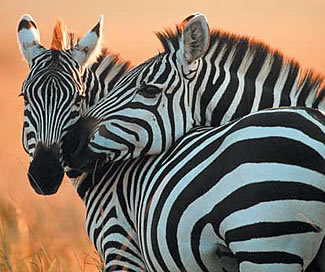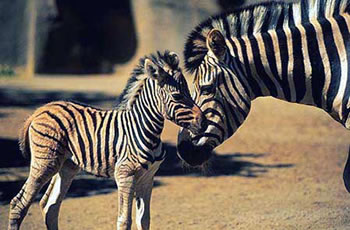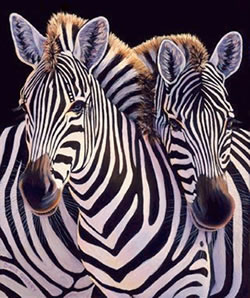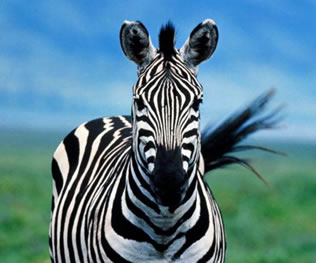
Zebras at first sight remind us of horses. As in the case of horses, zebras, too, have hair which we call a "mane". Their body structures are also very similar to horses and they run as fast as them.
Yet, their appearance is strikingly different. As you might also suppose, this difference lies in the straight stripes that cover their bodies from head to toe. Do not underestimate a stripe, since these stripes are different in every single zebra. Just like the fingerprint, which is unique to every person, the stripes of zebras are all different. Stripes provide identification data for a zebra just like an ID card does for humans. The vertical stripes of zebras are also an important element of defence. When they come together, tigers and lions perceive the herd as a whole. In this case, it becomes difficult for the predator to choose the individual zebra, which becomes a protection for the zebras.
There are two essential elements necessary for zebras to survive: water and grass.

At times, a zebra herd wanders for 50 kilometres (31 miles) to find water and grass. But at nights they return to their own places. That is because, as we mentioned earlier about other animals, each herd leads its life in a particular territory.
Do you know that zebras very much like to take dust-baths? Indeed, zebras are very fond of dust-baths. That is because, dust-baths remove the parasites living on their bodies. Apart from this, zebras have guests that accompany them and help them in their cleaning. Oxpeckers feed on the ticks found on the hides of zebras. This way, one by one they pick the parasites that make zebras sick and cause them to itch. As you see, our Lord, Who plans and controls the lives of all the creatures and makes them helpers for each other, has also assigned some animals as helpers of others.

About half an hour after birth, a new-born zebra stands up and begins to walk, though in a faltering trembling manner. No sooner do they walk than they begin to suck their mothers' milk. Milk is very beneficial for a new-born creature. This milk, which is pink in colour by a special creation of Allah, protects them from illnesses from birth onwards. Besides that, it secures the proper functioning of their intestines.
Zebras, as is the case with all other creatures under Allah's protection, are equipped with defence mechanisms that Allah has taught them. The first of these defence mechanisms is their very sensitive sensory organs, such as seeing, hearing and smell, which Allah has given them at birth. The sensitivity of these sensory organs enables zebras to notice their predators quickly and run away. No sooner do they begin to run than they reach an incredible speed. The second defence mechanism is the following: when the herd fall asleep, one or two zebras stay awake and watch out for possible threats.
Zebras employ the defence tactics that are similar to those of human beings. However, it is interesting that these animals live in harmony in herds and make a division of labour. It is obvious that it is Allah Who creates zebras, collects them together and provides their sustenance and Who commands them to make a division of labour. If this was not the case, no one would be able to explain why some zebras make sacrifices such as staying awake all night long to protect the others.

On the other hand, for the new-born zebra who has recently opened his eyes to this world, the defence tactics Allah has taught him are much simpler. All he has to do is stay close to his mother. That is because, it is impossible for a new-born zebra to see stealthy enemies with his newly opened eyes or run away from them with his weak, trembling limbs. You see, Allah has inspired the new-born zebra to remain next to his mother always until he grows up. Otherwise, how could he know that there are predators around waiting for him and that the most secure place for him is with his mother?
Most zebras live on open grasslands where there is not much possibility to hide. For this reason, in order to stay alive, they need to move very fast. All the body structure of a zebra is devised to meet this need. For instance, their limbs are very long; they can run very long distances without becoming exhausted or losing speed. Although light, the bones of zebras are very strong.
Zebras feel the need to drink water very often. In regions where water is scarce, they use their sharp sense of smell and dig a hole to reach fresh water. In moments of danger, mature zebras push young zebras into the middle of the herd to protect them. As the zebras run together, young animals always remain inside the herd and run close to their mothers for better protection.